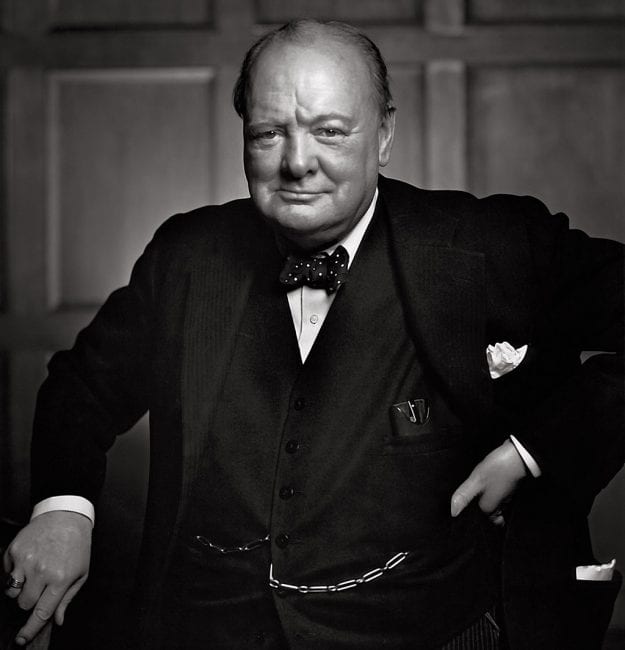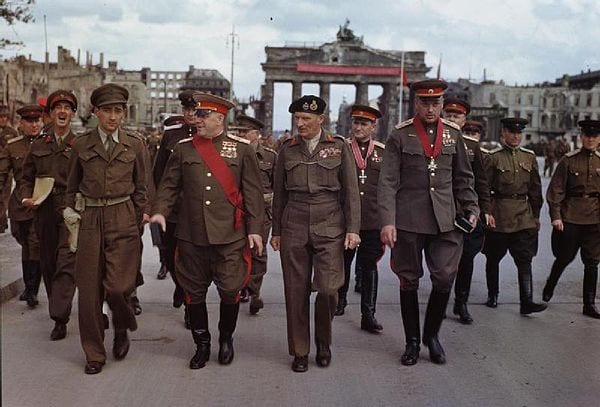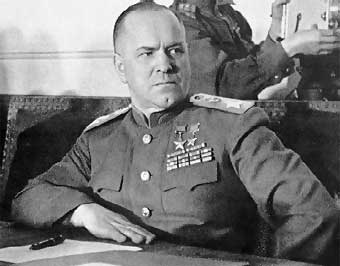World War II: “Operation Unthinkable”, Churchill’s Planned Invasion of the Soviet Union, July 1945
 Yuriy Rubtsov | Global Research } Strategic Culture Foundation
Yuriy Rubtsov | Global Research } Strategic Culture Foundation
 Churchills’ bald-faced treachery —conveniently whitewashed by establishment historians and Hollywood, which has done ludicrous hagiographic portraits of the man to hide his vicious imperialist streak—shows once again that class interests dominate state policy, and that the capitalist powers never intended to halt their hostilities against the Soviet Union. Shamefully, once again “Perfidious Albion”* led the charge.—Eds.
Churchills’ bald-faced treachery —conveniently whitewashed by establishment historians and Hollywood, which has done ludicrous hagiographic portraits of the man to hide his vicious imperialist streak—shows once again that class interests dominate state policy, and that the capitalist powers never intended to halt their hostilities against the Soviet Union. Shamefully, once again “Perfidious Albion”* led the charge.—Eds.
[dropcap]I[/dropcap]n late May 1945 Josef Stalin ordered Marshall Georgy Zhukov to leave Germany and come to Moscow. He was concerned over the actions of British allies. Stalin said the Soviet forces disarmed Germans and sent them to prisoners’ camps while British did not. Instead they cooperated with Germans troops and let them maintain combat capability.
Stalin believed that there were plans to use them later. He emphasized that it was an outright violation of the inter-governmental agreements that said the forces surrendered were to be immediately disbanded. The Soviet intelligence got the text of secret telegram sent by Winston Churchill to Field Marshall Bernard Montgomery, the commander of British forces. It instructed to collect the weapons and keep them in readiness to give back to Germans in case the Soviet offensive continued.

The Big Three at Yalta. Stalin correctly saw that the Anglo-American “allies” would soon turn their weapons and resources against the USSR.
According to the instructions received from Stalin, Zhukov harshly condemned these activities speaking at the Allied Control Council (the Soviet Union, the United States, the United Kingdom and France). He said the world history knew few examples of such treachery and refusal to observe the commitments on the part of nations that had an allied status. Montgomery denied the accusation. A few years later he admitted that he received such an instruction and carried it out. He had to comply with the order as a soldier.
A fierce battle was raging in the vicinity of Berlin. At this time Winston Churchill said that Soviet Russia had become a deadly threat to the “free world.” The British Prime Minister wanted a new front created in the east to stop the Soviet offensive as soon as possible. Churchill was overwhelmed by the feeling that with Nazi Germany defeated a new threat [had] emerged posed by the Soviet Union.
That’s why London wanted Berlin to be taken by Anglo-American forces. Churchill also wanted Americans to liberate Czechoslovakia and Prague with Austria controlled by all allies on equal terms.

Marshall Zhukov (with red sash) in Berlin, flanked on his left by Britain’s Gen. Montgomery. (1945). The Brandenburg Gate stands in the back.
Not later than April 1945 Churchill instructed the British Armed Forces’ Joint Planning Staff to draw up Operation Unthinkable, a code name of two related plans of a conflict between the Western allies and the Soviet Union. The generals were asked to devise means to,
“impose upon Russia the will of the United States and the British Empire”.
The hypothetical date for the start of the Allied invasion of Soviet-held Europe was scheduled for 1 July 1945. In the final days of the war against Hitler’s Germany, London started preparations to strike the Soviet Union from behind.
The plan envisioned unleashing a total war to occupy the parts of the Soviet Union which had a crucial significance for its war effort and deliver a decisive blow to the Soviet armed forces making the USSR unable to continue fighting.
The plan included the possibility of Soviet forces retreating deep into the territory according to the tactics used in previous wars. The plan was taken by the British Chiefs of Staff Committee as militarily unfeasible due to a three-to-one superiority of Soviet land forces in Europe and the Middle East, where the conflict was projected to take place. German units were needed to balance the correlation of forces. That’s why Churchill wanted them to remain combat capable.
The War Cabinet stated:
“The Russian Army has developed a capable and experienced High Command. The army is exceedingly tough, lives and moves on a lighter scale of maintenance than any Western army, and employs bold tactics based largely on disregard for losses in attaining its objective. Equipment has improved rapidly throughout the war and is now good. Enough is known of its development to say that it is certainly not inferior to that of the great powers. The facility the Russians have shown in the development and improvement of existing weapons and equipment and in their mass production has been very striking. There are known instances of the Germans copying basic features of Russian armament.”
The British planners came to pessimistic conclusions. They said any attack would be “hazardous” and that the campaign would be “long and costly”. The report actually stated:
“If we are to embark on war with Russia, we must be prepared to be committed to a total war, which would be both long and costly.” The numerical superiority of Soviet ground forces left little chance for success. The assessment, signed by the Chief of Army Staff on June 9, 1945, concluded: “It would be beyond our power to win a quick but limited success and we would be committed to a protracted war against heavy odds. These odds, moreover, would become fanciful if the Americans grew weary and indifferent and began to be drawn away by the magnet of the Pacific war.”
The Prime Minister received a draft copy of the plan on June 8th. Annoyed as he was, Churchill could not do much about it as the supremacy of the Red Army was evident. Even with a nuclear bomb in the inventory of US military, Harry Truman, the new American President, had to take it into account.
Meeting Soviet Foreign Minister Vyacheslav Molotov, President Truman took the bull by the horn. He made a thinly veiled threat to use economic sanctions against the Soviet Union.
The Yalta conference: Stalin, Roosevelt and Churchill
On May 8, the US President ordered to greatly reduce the lend-lease supplies [military aid] without prior notification. It went as far as the return US ships already on the way to the Soviet Union back to home bases. Some time passed and the order to reduce the land lease was cancelled otherwise the Soviet Union would not have joined the war against Japan, something the United States needed. But the bilateral relationship was damaged.
The memorandum signed by Acting Secretary of State Joseph Grew on May 19, 1945 stated that war with the Soviet Union was inevitable. It called for taking a tougher stand in the contacts with the Soviet Union. According to him, it was expedient to start the fighting before the USSR could recover from war and restore its huge military, economic and territorial potential.
The military received an impulse from politicians. In August of 1945 (the war with Japan was not over) the map of strategic targets in the USSR and Manchuria was submitted to General L. Groves, the head of US nuclear program. The plan contained the list of the 15 largest cities of the Soviet Union: Moscow, Baku, Novosibirsk, Gorky, Sverdlovsk, Chelyabinsk, Omsk, Kuibyshev, Kazan, Saratov, Molotov (Perm), Magnitogorsk, Grozny, Stalinsk (probably Stalino – the contemporary Donetsk) and Nizhny Tagil. The targets were given descriptions: geography, industrial potential and the primary targets to hit. Washington opened a new front. This time it was against its ally.
London and Washington immediately forgot they fought shoulder to shoulder with the Soviet Union during the Second World War, as well as the their commitments according to the agreements reached at the Yalta, Potsdam and San-Francisco conferences.
It is events like these that have made the world what it is.
ABOUT THE AUTHOR
 [box] Yuriy Rubtsov serves as Professor at the Military University of the Russian Ministry of Defense (Moscow). His analyses can be found in some of the leading geopolitical sites on the web, including the Strategic Culture Foundation, Voltaire.Net [/box]
[box] Yuriy Rubtsov serves as Professor at the Military University of the Russian Ministry of Defense (Moscow). His analyses can be found in some of the leading geopolitical sites on the web, including the Strategic Culture Foundation, Voltaire.Net [/box]
* Perfidious Albion in this context refers to the British ruling class, not the British people in general, and certainly not its workers.
preparée par Le Saker francophone.
[learn_more caption=”CLIQUER ICI”]
1945 – Opération Unthinkable, naissance de la Guerre Froide
Par Yuriy Rubtsov. Professeur à l’Université militaire du ministère russe de la Défense.
Le 25 mai 2015 – Source strategic-culture
[dropcap]À[/dropcap] la fin de mai 1945, Josef Staline a ordonné au Marshall Georgy Zhukov de quitter l’Allemagne et de venir à Moscou. Il était préoccupé par les actions des alliés britanniques. Staline a déclaré que les forces soviétiques désarmaient les Allemands et les envoyaient dans les camps de prisonniers tandis que les Britanniques ne le faisaient pas. Au contraire, ils ont coopéré avec les troupes allemandes pour qu’elles maintiennent leurs capacités de combat. Staline a pensé qu’il y avait des plans pour les utiliser plus tard. Il a souligné que c’était une violation flagrante de l’accord inter-gouvernemental qui a déclaré que les forces qui se rendaient devaient être immédiatement dissoutes. Les Services de renseignement soviétiques ont obtenu le texte du télégramme secret, envoyé par Winston Churchill au maréchal Bernard Montgomery, le commandant des forces britanniques. Il le chargeait de recueillir les armes et de les garder prêtes pour les rendre aux Allemands dans le cas où l’offensive soviétique se serait poursuivie. Selon les instructions reçues de Staline, Joukov a sévèrement condamné ces activités devant le Conseil de contrôle allié (l’Union soviétique, les États-Unis, le Royaume-Uni et la France). Il a dit que l’histoire du monde connaissait peu d’exemples d’une telle trahison et du refus de respecter leurs engagements de la part de nations qui avaient un statut d’alliées. Montgomery a nié l’accusation.
[dropcap]Q[/dropcap]uelques années plus tard, il a admis qu’il avait reçu une telle instruction et l’avait exécutée. Il devait se conformer à l’ordre comme un soldat. Une bataille acharnée [les russes seuls face aux nazis, NdT] faisait rage dans les environs de Berlin. En son temps, Winston Churchill avait dit que la Russie soviétique était devenue une menace mortelle pour le monde libre. Le Premier ministre britannique a voulu créer un nouveau front à l’Est pour arrêter l’offensive soviétique dès que possible. Churchill était obsédé par le sentiment qu’après la chute de l’Allemagne une nouvelle menace émergeait du fait de l’Union soviétique. Voilà pourquoi Londres voulait que Berlin soit prise par les forces anglo-américaines. Churchill voulait aussi que les Américains libèrent la Tchécoslovaquie et Prague avec une Autriche contrôlée par tous les alliés sur un pied d’égalité. Pas plus tard qu’en avril 1945, Churchill a chargé l’État-major interarmées de planification des forces armées britanniques de mettre en place Opération Unthinkable [Opération impensable], nom de code de deux plans connexes pour un conflit entre les alliés occidentaux et l’Union soviétique. On a demandé aux généraux de concevoir les moyens d’«imposer à la Russie la volonté des États-Unis et de l’Empire britannique».
[dropcap]L[/dropcap]a date hypothétique pour le début de l’invasion alliée de l’Europe tenue par les Soviétiques a été prévue pour le 1er juillet 1945. Dans les derniers jours de la guerre contre l’Allemagne hitlérienne, Londres se préparait déjà à frapper l’Union soviétique par derrière. Le plan envisageait de déclencher une guerre totale pour occuper les parties de l’Union soviétique qui avaient une signification cruciale pour son effort de guerre et de livrer ainsi un coup décisif aux forces armées soviétiques rendant l’URSS incapable de continuer le combat. Le plan prévoyait la possibilité d’une retraite en profondeur des forces soviétiques dans leur territoire selon les tactiques utilisées dans les guerres précédentes. Le plan a été estimé irréalisable par les chefs de l’état-major britannique en raison de la supériorité numérique des forces terrestres soviétiques, dans un rapport de un à trois en Europe, et au Moyen-Orient où le conflit était aussi projeté. Les unités allemandes étaient nécessaires pour équilibrer le rapport des forces. Voilà pourquoi Churchill voulait qu’ils restent aptes au combat.
Le Cabinet de guerre, a déclaré : «L’armée russe a développé un haut commandement capable et expérimenté. L’armée est extrêmement robuste, vit et se déplace avec des moyens de survie plus légers que toutes les armées de l’Ouest, et emploie des tactiques audacieuses fondées en grande partie sur le mépris des pertes dans la réalisation de son objectif. L’équipement s’est rapidement amélioré pendant toute la guerre et est maintenant bon. On en sait assez sur son développement pour dire qu’il n’est certainement pas inférieur à celui des grandes puissances. La facilité que les Russes ont montrée dans le développement et l’amélioration des armes et des équipements existants et dans leur production de masse a été très frappante. Il y a des cas connus où les Allemands ont copié les fonctions de base de l’armement russe.»
Les planificateurs britanniques sont arrivés à des conclusions pessimistes. Le rapport effectivement déclare : «Si nous nous lançons dans la guerre avec la Russie, nous devons être prêts à être engagés dans une guerre totale, qui serait à la fois longue et coûteuse.» La supériorité numérique des forces terrestres soviétiques laisse peu de chance au succès. L’évaluation, signée par le chef d’état-major de l’Armée, le 9 juin 1945, a conclu: «Il est au-delà de notre pouvoir de remporter un succès rapide mais limité et nous serons engagés dans une guerre prolongée contre de lourds aléas. Ces aléas, d’ailleurs, deviendraient fantaisistes si les Américains se lassaient et devenaient indifférents, attirés au loin par l’aimant de la guerre du Pacifique.» Le Premier ministre a reçu une copie du projet de plan le 8 juin. Agacé comme il l’était, Churchill ne pouvait pas faire grand-chose à ce sujet tellement la suprématie de l’Armée rouge était évidente. Même avec une bombe nucléaire dans les stocks de l’armée américaine, Harry Truman, le nouveau président américain, a dû en tenir compte. En rencontrant le ministre soviétique des Affaires étrangères Viatcheslav Molotov, le président Truman a pris le taureau par les cornes. Il a fait une menace à peine voilée à l’utilisation de sanctions économiques contre l’Union soviétique. Le 8 mai, le président américain a ordonné de réduire considérablement les fournitures du prêt-bail sans notification préalable. Au point que les navires américains, déjà sur le chemin de l’Union soviétique, sont retournés dans leurs bases.
[dropcap]P[/dropcap]eu de temps après, l’ordre de réduire le prêt-bail a été annulé, sinon l’Union soviétique n’aurait pas rejoint la guerre contre le Japon, quelque chose dont les États-Unis avaient grand besoin. Mais la relation bilatérale a été endommagée. Le mémorandum signé par le secrétaire d’État par intérim Joseph Grew le 19 mai 1945 déclarait que la guerre avec l’Union soviétique était inévitable. Il appelait à prendre une position plus ferme dans les relations avec l’Union soviétique. Selon lui, il était opportun de commencer le combat avant que l’URSS ne puisse se remettre de la guerre et restaurer son immense armée, son potentiel économique et territorial. Les militaires étaient poussés par les politiciens. En août 1945 (la guerre avec le Japon était en cours), un plan des cibles stratégiques en URSS et en Mandchourie a été soumis au général L. Groves, le chef du programme nucléaire US. Le plan contenait la liste des quinze plus grandes villes de l’Union soviétique : Moscou, Bakou, Novosibirsk, Gorki, Sverdlovsk, de Tcheliabinsk, Omsk, Kouibychev, Kazan, Saratov, Molotov (Perm), Magnitogorsk, Grozny, Stalinsk (le Donetsk contemporain ) et Nizhny Tagil. Les cibles ont été décrites : géographie, potentiel industriel et les priorités de frappe. Washington ouvrait un nouveau front. Cette fois contre son allié. Londres et Washington ont immédiatement oublié qu’ils ont combattu au coude à coude avec l’Union soviétique pendant la Seconde Guerre mondiale, ainsi que les engagements pris aux conférences de Yalta, Potsdam et San Francisco. Yuriy Rubtsov
Traduit par jj, relu par Diane pour le Saker Francophone[/learn_more]
[printfriendly]
Remember: All captions and pullquotes are furnished by the editors, NOT the author(s).
What is $5 a month to support one of the greatest publications on the Left?

